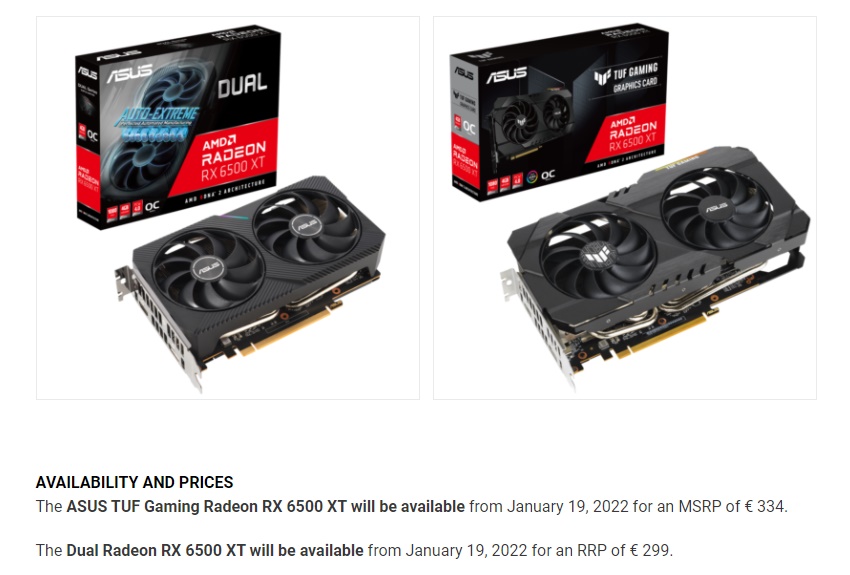Asus Reveals Official RX 6500 XT European €299 MSRP
Asus, via its German division, has confirmed the official MSRP for the AMD Radeon RX 6500 XT in European markets.
Asus Germany has revealed just how much its boards based on AMD's recently-announced RX 6500 XT GPUs are going to cost for end-users. European consumers hoping to acquire a budget graphics card have to face an MSRP set at ~$338 (€299) - a 70% increase in the sticker price even before the first cards hit hardware stores.
Asus revealed the MSRP for two of its upcoming RX 6500 XT graphics cards: the Asus Dual Radeon RX 6500 XT appears to be the entry-level offering, and has been set at the €299 level. If you're looking for a card that offers some additional features - such as dual BIOS, higher clocks, and a better choice of internal components - then the Asus RX 6500 XT TUF could be the card for you. However, that card has been priced even higher; Asus' MSRP is set at €334 (~$374), or 87% above AMD's official MSRP.

Being an official Asus pricing guideline, this doesn't bode well for the general pricing of the RX 6500 XT - AMD's other board partners are unlikely to set their pricing much lower when one manufacturer is increasing its margins by this much. Asus is certainly setting its prices higher than MSRP to pre-emptively adjust to the pent-up demand arising from more than a year of supply-constrained GPU products targeted by scalpers.
It's unclear exactly how and why Asus has arrived at this particular pricing for the RX 6500 XT. As we've previously covered, the RX 6500 XT is a card that has seemingly been made with an eye on cost-cutting. Even if it uses the most advanced manufacturing process of any current AMD graphics card, TSMC's 6nm, its 64-bit bus, 4 GB of VRAM and the PCIe 4.0 x4 interface speak volumes about AMD's design decisions. And if the general narrative is that cryptocurrency miners are the most significant source of demand for graphics cards, AMD's design decision of limiting VRAM to 4 GB places the card in "unmineable" territory - at least for the most popular GPU mining workloads.
The quoted MSRP does, however, put the RX 6500 XT in a bad spot compared to the competition - particularly Nvidia's RTX 3050 graphics card, with its $269 MSRP. Of course, Nvidia's pricing (and that of its board partners) is also more of a statement of faith than reality. This does however mean that users looking to get a new-gen graphics card will face increased prices wherever they look. If the 4 GB, PCie 4.0 x4, 64-bit bus RX 6500 XT and its 6 nm, 141 mm² die is being sold at 70% above its $199 MSRP, we can only wait in horror to discover what pricing manufacturers find adequate for the 8 GB, PCIe 4.0 x16, 128-bit bus and 276 mm² die of the desktop RTX 3050.
Get Tom's Hardware's best news and in-depth reviews, straight to your inbox.

Francisco Pires is a freelance news writer for Tom's Hardware with a soft side for quantum computing.
-
Neilbob Why do I have a sneaking suspicion that manufacturers are engaging in a just a teeny-tiny little bit of greed here?Reply
And I thought the 1660 Super I got for £260.00 (about €320 I think?) almost exactly 1 year ago was lousy value for money - it was literally the only thing available that wasn't complete cr*p when my last GPU very inconveniently died at the height of the shortage/scalpedemic. -
InvalidError RX590-class performance with a cut-down frame buffer, halved PCIe bandwidth four years later for 30% more dollars. The performance-per-dollar value regression is getting worse at a ridiculous pace.Reply -
-Fran- Reply
Hm... Not to defend AMD or anything that's going on here with the insane prices, but how is the inflation vs the lackluster releases as of late? Context is your comment about "performance-per-dollar", which I think is interesting to put some numbers to it.InvalidError said:RX590-class performance with a cut-down frame buffer, halved PCIe bandwidth four years later for 30% more dollars. The performance-per-dollar value regression is getting worse at a ridiculous pace.
Regards. -
InvalidError Reply
AMD's own RX6500 presentation says it will only be 10-20% faster than the RX580, which is roughly RX590 territory. The 8GB RX580 could be had for $120 or less before the crypto craze flared up for the second time. Since the RX570-590 have roughly twice as much VRAM bandwidth (256bits x 8GT/s vs 64bits x 16-18GT/s), 8GB models have twice as much VRAM and all have a full 3.0x16 interface, I bet there will be many scenarios where the four years old designs will beat the massively crippled RX6500.-Fran- said:Hm... Not to defend AMD or anything that's going on here with the insane prices, but how is the inflation vs the lackluster releases as of late? Context is your comment about "performance-per-dollar", which I think is interesting to put some numbers to it.
The only good thing about the RX6500 is that it will use about half as much power. -
-Fran- Reply
As I said, I'm not defending the awful card the 6500XT is. I know what it is and how awful the optics are. I'm just curious about putting some actual numbers behind the assessment of "performance-per-dollar" taking inflation into account. I could do the math myself, but I'm too lazy today, haha.InvalidError said:AMD's own RX6500 presentation says it will only be 10-20% faster than the RX580, which is roughly RX590 territory. The 8GB RX580 could be had for $120 or less before the crypto craze flared up for the second time. Since the RX570-590 have roughly twice as much VRAM bandwidth (256bits x 8GT/s vs 64bits x 16-18GT/s), 8GB models have twice as much VRAM and all have a full 3.0x16 interface, I bet there will be many scenarios where the four years old designs will beat the massively crippled RX6500.
The only good thing about the RX6500 is that it will use about half as much power.
Regards. -
InvalidError Reply
There has only been 6-7% of real inflation over the last five years, the rest is just everyone price-gouging everyone else because everyone else is trying to price-gouge everyone. Since the RX6500 is a significantly pared-down product relative to the RX580 and made on a finer process which has much lower net cost per transistor than 12/16nm, the silicon should still be cheaper despite inflation and TSMC's price-gouging.-Fran- said:As I said, I'm not defending the awful card the 6500XT is. I know what it is and how awful the optics are. I'm just curious about putting some actual numbers behind the assessment of "performance-per-dollar" taking inflation into account. I could do the math myself, but I'm too lazy today, haha.
Were it not for crypto driving GPU prices to the moon and forcing budget buyers to compete for garbage like the RX6500, this would be a ~$120 GPU. -
daworstplaya I feel sorry for the people that will actually pay that price for the garbage this card represents.Reply